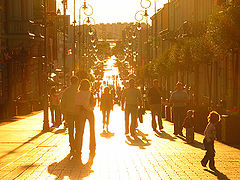
Sienkiewicza Street, Kielce
Encyclopedia

Kielce
Kielce ) is a city in central Poland with 204,891 inhabitants . It is also the capital city of the Świętokrzyskie Voivodeship since 1999, previously in Kielce Voivodeship...
, Poland
Poland
Poland , officially the Republic of Poland , is a country in Central Europe bordered by Germany to the west; the Czech Republic and Slovakia to the south; Ukraine, Belarus and Lithuania to the east; and the Baltic Sea and Kaliningrad Oblast, a Russian exclave, to the north...
. It was built in the middle of the 19th century. It was originally called Konstantego Street, then Postal Street and in 1919 it received its present name. Shops and department stores are located there as well as historic buildings and monuments. It is approximately 1270 metres long and runs from the railway station situated next to the Independence square to the Moniuszki square.
History
The early street began at the end of the seventeenth century. At that time, Kielce had about 1500 permanent inhabitants. In 1789 there were only 6 brick houses – four of them were situated right by the main square and the other two on Mała street. The city had 252 houses then. The coming Sienkiewicza street ran between the “bishops’ town” and the residences of citizens. It wasn’t covered with any paving, as a result mud was an everyday occurrence there. In the easterly direction, the road disappeared in fields, while it led to the swampy bank of the Silnica river to the west.In 1821 Marian Potocki, an official land surveyor of the Polish Kingdom, created a spatial planning of Kielce. The plan considered in its conception the leading role of Kielce as an administrative, educational and service centre. The city attempted to become modernised without radical redevelopment of the downtown by the growth of areas of settlement, and adjustment of currently existing streets while building new ones. According to Potocki’s plan, Sienkiewicza street had its beginning next to the Leonarda square, while the other end led to nowhere. It didn’t end at the designed square at the junction of Leśna and Kapitulna streets but it went all the way to Silnica and continued onwards in a westerly direction. Probably, the plan was to merge Sienkiewicza with the centre of mining and ferrous metallurgy. (Czarnów, Szczukowskie Górki, Karczówka)
In 1823, the present Sienkiewicza Street, on the initiative of Marian Potocki, was named after the Great Prince Konstanty Pawłowicz, the chief executive officer of the Polish Kingdom army. He was the most important personage in the Polish Kingdom and in fact (after the death of general Józef Zajączek) also the tsarist governor. Konstanty street was cobbled in order to enable water transport in case of fire and quicker and also because it led to government offices (mortgagees, post offices and school). It ended at the junction of Leśna and Kapitulna Streets.
At that time the Silnica River wasn’t bridged. In order to cross the river citizens had to ford it. After the outbreak of a November Uprising the Konstanty street began to be called Postal Street – after the building of a post office that was situated on it. Soon it became the representative street of the city. In 1840 an impressive house with stables, inns and a theatre hall was built. Attached to the building there was a mortgagee, a post office and a school. In 1887 an industrialist, Ludwik Stumpf, began construction of the theatre which was, soon afterwards, called the Ludwik Theatre (nowadays Stefan Żeromski Theatre). Many people came there to watch performances. Among the audience were local gentry, citizens, youths and Russian officers of regiments stationing in the city.
On July 5, 1881 a concession was granted to build a road which was to connect Dęblin
Deblin
Dęblin is a town, population 19,500 , at the confluence of Vistula and Wieprz rivers, in Lublin Voivodeship, Poland. Dęblin is the part of the agglomeration with adjacent towns of Ryki and Puławy, which altogether has over 100 000 inhabitants....
with Zagłebie Dąbrowskie. Soon, contractors started building the railway and along with tracks also a station. The first steam locomotive came to Kielce on December 21, 1883. The building of the railway station was finished in 1885. It was erected in the middle of the field, on the line of Sienkiewicza Street. This construction lasted until the 1960s.
Originally, when a small bridge was built on the Silnica, the part of the street which was marked off was called Russian Street, or more popularly, Railway Street. Thanks to that investment a big building space between the city and the railway station came into being. The extension of the street involved social changes.
Marking out another part of today’s Sienkiewicza Street resulted in the inflow of Jewish to Kielce. They started to invest in building lots. Between the Czysta and Żelazna Streets, on the southern side, there was a non-built-up area on which arable lands were located. It was surrounded by a fence from side of the Sienkiewicza Street.
External links
- City guide to Kielce in English;
- Sienkiewicza Street in Polish;
- Webcam on Sienkiewicza Street;

